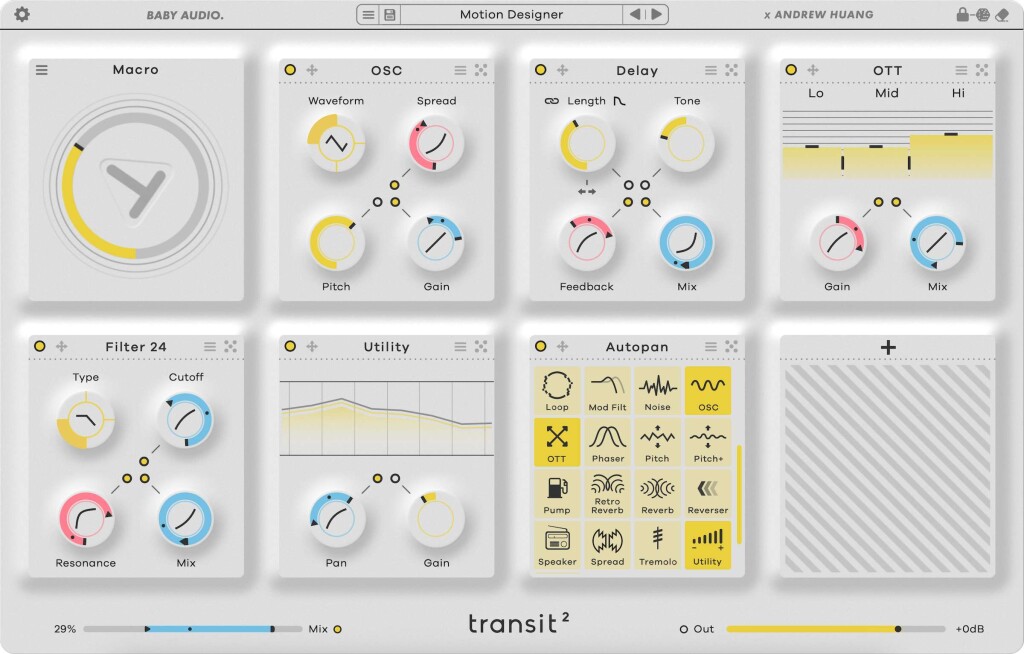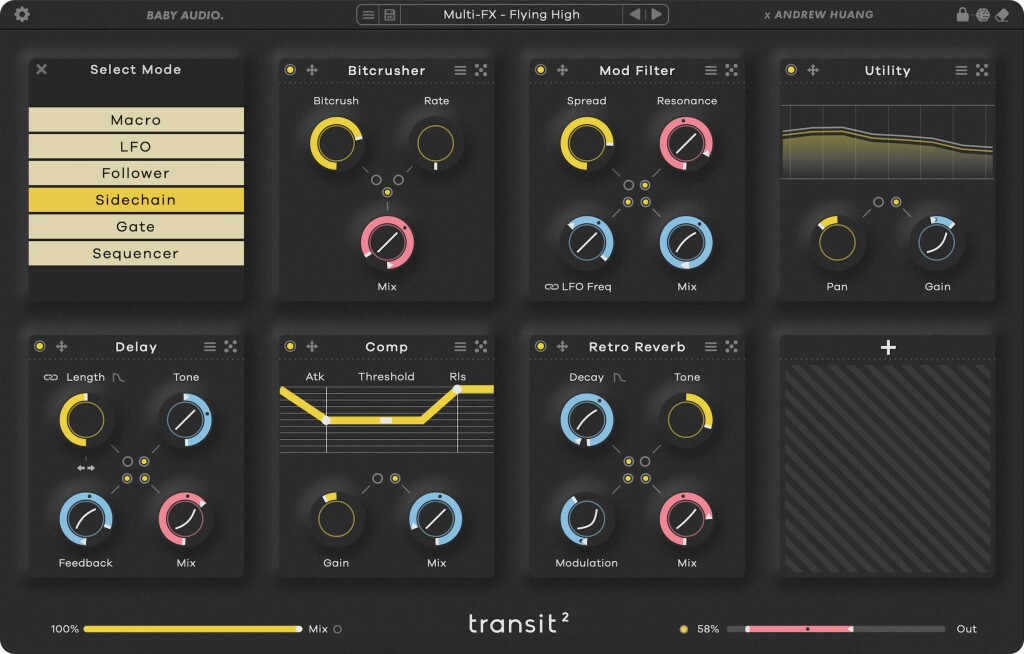Billed at launch as a “transition designer,” it was clear from the start that Transit 2 was a multi-effects workstation. Now, the Baby Audio / Andrew Huang collab has delivered on that with new effects and Motion Modes, making this a “motion effects playground.”

And why not? If you’re going to trigger some automation motion and effects layers on a breakdown, Transit 2’s macro controls and various effects modules already lent themselves to use as multi-effects throughout. (Yes, yes, that could also get hectic in a hurry, but arguably, you could use the same controls to tame multi-effects routings.)
That’s what I wrote in the original Transit review, so I’m gratified to see some new additions here with that in mind. How often do I want massive EDM-style transitions and breakdowns? Almost never. How often do I want some layered effects with motion? Often! And yet while this can ease transitions, it’s true, it may well be its use went beyond that.
Oh, plus – they did sneak one tidbit into the press release: an iOS version is inbound. That might make even more sense for many use cases – you often need effects in a live rig, and a lot of the hardware out there involves way too much menu diving. Plus, the iOS version should answer the “can’t I just do this in an Ableton Effects Rack or with automation?” crowd. (Answer: yes, in theory, though often with a lot more hacking.)
This is a first a hands-on, not a full review, but it’s already Transit was fun, and Transit 2 refines the UI from the original and adds a ton more stuff.
New Motion Modes: LFO, Follower, Sidechain, and Gate.
LFO: sine, tri, saw, square, with sync option and Smooth (which means you can actually get additional shapes out of it).
Gate: with duration, pendulum option, looping.
Sidechain, Follower: each with attack, release, range, sensitivity.
…in addition to the existing Sequencer and Macro options.
Let’s say that again – this is what the original version wanted, as the whole point was having an all-in-one effects device with control.
These are tucked into the UI in the same economical way as before, too. That’s what to me sets this apart: instead of a mess of windows and devices, you get a simple, clean control panel for all your effects.
Instead of a mess of windows and devices, you get a simple, clean control panel for all your effects.

There’s more, too:
New effects give you strong SP-404-on-the-desktop vibes:
Loop: stutter and repeat.
Reverser: tempo-synced (or not) reverse playback with speed settings.
Warp: pitch shift and time stretch – again designed “for transition effects,” though you really don’t have to use them this way.
Retroverb: 80s-style Feedback Delay Reverb model.
Mod filter: Stereo filter bank with hypnotic possibilities.
Compressor: downwards compressor so you have an alternative to the extreme OTT effect (which, to be fair, literally stands for “over the top”).
Pitch+: cleaner pitch shifter with tempo-syncable LFO.
Speaker: transistor radio … ooh, yes, as we enjoyed on Baby’s synth.
Analog chorus: because sometimes you want a BBD chorus.
EQ: because sometimes you want a 3-band EQ.
(Curious if there are any you feel they left out – let us know in comments.)
To me, that rounds out the toolset from V1, and the new stuff sounds great – now with some more refined options. Honestly, part of what has kept me from going back to Transit V1 was just that I missed effects from elsewhere; this makes the all-in-one approach make a bit more sense. (And I’d never expect less from the folks who made Spaced Out.)
More presets: 469, bringing the total to 838.
The new workflow is all integrated – more on that soon.
Transit 2 product page:
The only bad news here – it’s not a free upgrade; it’s $29 for existing users.
There’s a $79 intro price running direct and via Plugin Boutique:
If you buy something from a CDM link, we may earn a commission.
Stay tuned, as I’m working on an exclusive CDM preset pack for you. I’ve admired Baby Audio’s effects from the beginning, and I do think Transit might have gotten missed by folks who dismissed it as a one-hit wonder. V2 really shows that it can be a solution for live jamming and motion – software effects with the kind of improvisatory feel of hardware rather than the usual studio-style “edit” workflow.
Check the review:
Plus, remember: